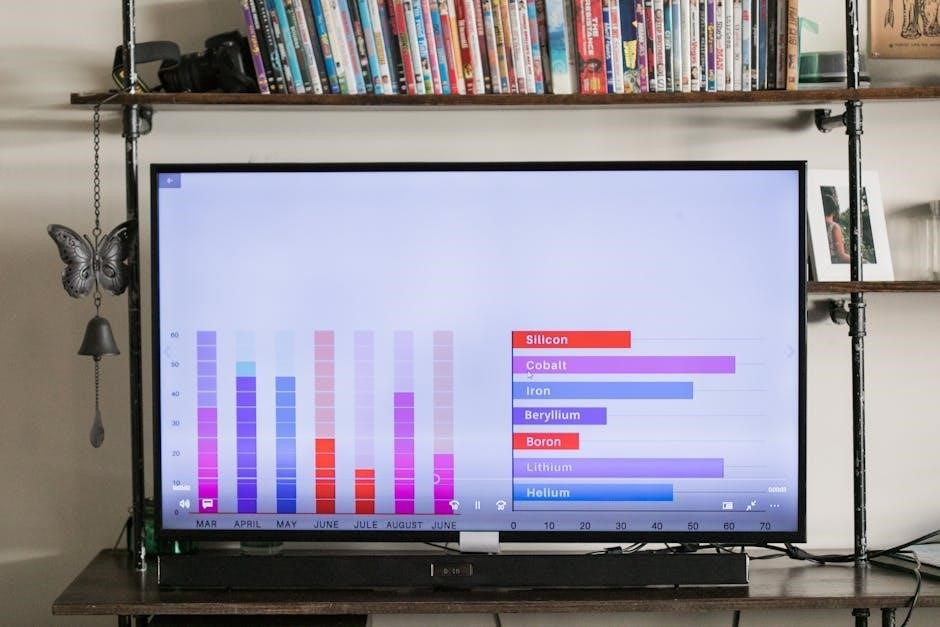Complete subject and predicate worksheets are educational tools designed to help learners identify and understand the two main parts of a sentence. These worksheets typically include exercises where students underline or circle the complete subject and predicate in given sentences, enhancing their grammar skills. They are widely used in classrooms and homeschooling to improve sentence structure and clarity. The worksheets often come with answer keys, providing feedback and reinforcing learning. They are an essential resource for educators and students alike, offering practical exercises for mastering grammar fundamentals.
1.1 Definition of Complete Subject and Complete Predicate
A complete subject is the entire noun or pronoun, along with its modifiers, that tells who or what the sentence is about. It includes all words that describe or modify the simple subject. On the other hand, a complete predicate is the part of the sentence that tells what the subject is doing or being. It includes the verb, objects, and any modifiers. Together, the complete subject and complete predicate form a full sentence, providing clarity and detail about the action or state described. Understanding these components is fundamental for constructing grammatically correct sentences.
1.2 Importance of Worksheets in Learning Grammar
Worksheets play a crucial role in grammar education by providing hands-on practice for identifying complete subjects and predicates. They offer structured exercises that help learners grasp foundational concepts through repetition and visualization. By underlining or circling specific parts of sentences, students develop a clearer understanding of sentence structure. Worksheets also serve as valuable tools for assessment, allowing educators to track progress and identify areas needing improvement. With answer keys included, learners receive immediate feedback, enhancing their ability to correct mistakes independently. Regular use of these resources fosters confidence and proficiency in constructing grammatically correct sentences, making them indispensable for effective grammar instruction.

Understanding the Complete Subject
The complete subject includes all words that identify who or what the sentence is about, including the simple subject and any modifiers or descriptors. It provides full context about the sentence’s topic, helping to clarify the subject’s role. Identifying the complete subject is essential for understanding sentence structure and improving grammar skills.
2.1 Simple Subject vs. Complete Subject
The simple subject is the main noun or pronoun in a sentence, while the complete subject includes all modifiers and descriptors. For example, in “The boy with the red shirt is running,” “boy” is the simple subject, and “The boy with the red shirt” is the complete subject. The simple subject provides the core identity, whereas the complete subject adds details, making sentences more descriptive. Understanding this distinction is crucial for constructing clear and detailed sentences. Worksheets often highlight this difference, helping learners identify and differentiate between the two effectively. This foundational knowledge strengthens overall grammar skills and sentence clarity.
2.2 Key Characteristics of a Complete Subject
A complete subject includes all the words that identify or describe the person, place, thing, or idea the sentence is about. It consists of the simple subject (the main noun or pronoun) and any accompanying modifiers, such as adjectives, articles, or prepositional phrases. For example, in “The tall student,” “The tall” is the complete subject, with “student” as the simple subject. The complete subject always appears at the beginning of a sentence and provides context or clarity about the topic. It is essential for forming clear and detailed sentences, as it gives the reader or listener more information about who or what is being discussed.
- Includes the simple subject and its modifiers.
- Appears at the start of the sentence.
- Provides context or description about the subject.

Understanding the Complete Predicate
The complete predicate includes the verb and all words that describe the action or state, providing a full understanding of what the subject is doing or being;
3.1 Simple Predicate vs. Complete Predicate
A simple predicate is the verb or action in a sentence, while a complete predicate includes the verb and all related words, such as modifiers and objects. For example, in “The sun is moving,” “is moving” is the simple predicate, and “The sun is moving” is the complete predicate. The complete predicate provides a full description of the action, making the sentence meaningful. Worksheets often highlight this distinction, helping learners understand how predicates contribute to sentence structure and clarity.
3.2 Key Characteristics of a Complete Predicate
A complete predicate includes all the words that describe the action or state of being in a sentence. It contains the verb and any modifiers, objects, or other elements that provide additional information. Unlike the simple predicate, which only includes the main verb, the complete predicate offers a fuller picture of what is happening. It can include adjectives, adverbs, direct objects, and prepositional phrases. The complete predicate works alongside the complete subject to form a complete sentence, ensuring clarity and completeness in expression. Identifying it helps in understanding the sentence’s overall meaning and structure.

How to Identify Complete Subject and Complete Predicate in Sentences
To identify the complete subject, locate the main noun and all modifiers describing it. For the complete predicate, find the verb and its accompanying details;
4.1 Step-by-Step Guide to Identifying Complete Subject
To identify the complete subject, follow these steps:
- Locate the main noun or pronoun: Start by finding the noun or pronoun that performs the action or is described in the sentence.
- Include all modifiers: Add any adjectives, articles, or prepositional phrases that describe the noun or pronoun.
- Check for compound subjects: If there are multiple nouns or pronouns connected by “and” or “or,” include all of them.
- Highlight the complete subject: Underline or circle the entire group of words that make up the subject.
For example, in the sentence “The sunny day brought smiles to everyone,” the complete subject is “The sunny day.” Practice with worksheets to master this skill.
4.2 Step-by-Step Guide to Identifying Complete Predicate
To identify the complete predicate, follow these steps:
- Locate the verb in the sentence, as it is the core of the predicate.
- Include all words that describe or modify the verb, such as adverbs or adjectives.
- Add any direct or indirect objects receiving the action of the verb.
- Underline the entire predicate, ensuring it includes all words after the complete subject.
Example: In “The dog ran quickly,” the complete predicate is “ran quickly,” describing the action and its manner. Always highlight the full predicate to understand the sentence’s meaning better.
The Importance of Learning Complete Subject and Complete Predicate
Learning complete subject and complete predicate enhances sentence structure, improves writing clarity, and ensures effective communication. It helps in understanding the core components of a sentence, making expressions more precise and meaningful. Worksheets with answers provide practical exercises to master these grammar fundamentals, essential for clear and accurate writing skills. This knowledge is vital for constructing well-formed sentences and conveying ideas effectively in both academic and everyday writing. By mastering these concepts, learners can express their thoughts more coherently and confidently. The ability to identify and use complete subjects and predicates is a foundational skill that supports overall writing proficiency and communication success. It is a crucial step in developing strong grammar skills, which are necessary for all forms of writing, from essays to professional documents. Understanding complete subject and complete predicate is key to improving sentence clarity and avoiding grammatical errors. It allows writers to present their ideas in a structured and organized manner, making their work more readable and professional. Additionally, this knowledge helps in breaking down complex sentences into manageable parts, facilitating better comprehension and analysis. By focusing on complete subject and complete predicate, learners can build a solid grammar foundation, which is essential for advanced writing techniques and stylistic improvements. Overall, mastering these concepts is a critical part of becoming a proficient writer and communicator.
5.1 Improving Sentence Structure
Understanding complete subjects and predicates is crucial for improving sentence structure. By identifying these components, learners can organize ideas more effectively, ensuring clarity and coherence. Worksheets with answers provide practical exercises to enhance this skill. They help students recognize how subjects and predicates work together to form meaningful sentences. This understanding reduces grammatical errors and enhances the flow of written content. Clear sentence structure improves readability, making communication more effective. With practice, learners can construct sentences that convey their intended message with precision and impact, laying a strong foundation for advanced writing skills and confident expression of ideas. This leads to better overall communication and academic success.
5.2 Enhancing Writing Skills
Mastering complete subjects and predicates significantly enhances writing skills by improving clarity and coherence in sentences. Worksheets provide hands-on practice, helping writers identify and structure these elements effectively. By understanding the complete subject and predicate, writers can craft more precise and engaging sentences, avoiding ambiguity. Regular practice with worksheets sharpens the ability to express ideas clearly, making communication more effective. This foundational skill is crucial for developing strong writing abilities, enabling learners to convey their thoughts with confidence and accuracy in various writing contexts.

Complete Subject and Complete Predicate Worksheets with Answers
These worksheets provide exercises for identifying complete subjects and predicates, with answers included for self-assessment. They feature sentences for underlining or circling, promoting accurate grammar practice.
6.1 Examples of Worksheets
Worksheets typically include sentences for students to identify and label the complete subject and predicate. For example:
- The school bus went down the street. (Underline the complete subject: The school bus, Circle the complete predicate: went down the street)
- The sun rises in the east. (Underline: The sun, Circle: rises in the east)
- Max wrote the letter carefully. (Underline: Max, Circle: wrote the letter carefully)
- The chocolate cake tasted very good. (Underline: The chocolate cake, Circle: tasted very good)
These exercises are followed by an answer key to verify responses and provide feedback.
6.2 Answer Key and Explanation
The answer key provides the correct identification of complete subjects and predicates for each exercise. It includes underlined complete subjects and circled complete predicates, ensuring clarity. For example, in “The school bus went,” “The school bus” is the complete subject, and “went” is the complete predicate. The key explains how modifiers and objects are included in the complete subject or predicate, aiding understanding. This section helps students verify their work, identify mistakes, and learn from corrections. Detailed explanations reinforce grammar concepts, making it easier for learners to grasp the differences between simple and complete components in sentences.

Detailed Analysis of Complete Subject and Complete Predicate
A complete subject includes the main noun and all its modifiers, while the complete predicate contains the verb and its objects or modifiers, forming a full thought.
7.1 Breaking Down Complete Subject
The complete subject encompasses the simple subject along with all its accompanying modifiers. It includes every word that provides information about who or what the sentence is about. For instance, in “The big red car drove down the street,” “The big red car” is the complete subject. Here, “car” is the simple subject, while “big” and “red” are adjectives modifying it. To identify the complete subject, look for the main noun or pronoun and any descriptive words or phrases attached to it. This method ensures a comprehensive understanding of the sentence’s focus, enhancing clarity in sentence structure and overall communication.
7.2 Breaking Down Complete Predicate
A complete predicate is the part of a sentence that tells what the subject is doing or what is happening to the subject. It includes the verb and all related modifiers, objects, or phrases. For example, in “The boy was running quickly in the park,” the complete predicate is “was running quickly in the park.” It contains the verb “running,” the adverb “quickly,” and the prepositional phrase “in the park,” providing a full picture of the action. Breaking it down helps in understanding how each component contributes to the sentence’s meaning, ensuring clarity and completeness in communication.

Common Mistakes in Identifying Complete Subject and Complete Predicate
Common errors include misidentifying simple and complete parts, overlooking modifiers, and confusing objects with predicates. Students often forget to include all descriptive words in the complete subject or predicate.
8.1 Misidentifying Simple and Complete Parts
One common mistake is confusing simple and complete parts of a sentence. The simple subject is just the main noun or pronoun, while the complete subject includes all modifiers. Similarly, the simple predicate is the main verb, and the complete predicate includes additional details like objects or modifiers. Students often overlook descriptive words or phrases, leading to incorrect identifications. For example, in “The sunny day made everyone happy,” the complete subject is “The sunny day,” not just “day.” Likewise, the complete predicate is “made everyone happy,” not just “made.” Practicing with worksheets helps learners avoid these errors by reinforcing clear distinctions.
8.2 Overlooking Modifiers and Objects
A common mistake when identifying complete subjects and predicates is overlooking modifiers and objects. Modifiers describe the subject, while objects complete the predicate. For example, in “The school bus went,” the modifier “school” is essential for identifying the complete subject. Similarly, in “Max wrote the letter,” “the letter” is the object completing the predicate. Ignoring these elements leads to incomplete identifications, making sentences unclear. Learners must carefully analyze each part of the sentence to ensure all modifiers and objects are included. This attention to detail improves accuracy and reinforces the understanding of sentence structure in worksheets.

Interactive Activities to Reinforce Learning
Engage students with online quizzes, grammar games, and group exercises. These activities make learning fun and interactive, reinforcing concepts of complete subjects and predicates effectively.
9.1 Online Quizzes and Games
Online quizzes and games are interactive tools that make learning about complete subjects and predicates engaging and fun. These resources often feature multiple-choice questions, drag-and-drop activities, and timed challenges to test students’ understanding. Many platforms offer scoring systems, providing immediate feedback to help learners track their progress. Games like “Identify the Complete Subject” or “Predicate Puzzle” turn grammar practice into an enjoyable experience. They are accessible on various devices, making them convenient for both classroom and home use. These digital activities complement traditional worksheets, offering a dynamic way to reinforce grammar concepts and improve retention of complete subject and predicate identification skills.
9.2 Group Exercises and Discussions
Group exercises and discussions are effective ways to engage students in learning about complete subjects and predicates. These activities encourage collaboration and peer learning, allowing students to share insights and clarify doubts. Teachers can organize pair or small group work where students identify and label complete subjects and predicates in sentences. Group discussions can follow, with students explaining their answers to the class. Such interactive methods enhance understanding and retention, as students learn from one another’s perspectives. Additionally, group exercises foster teamwork and communication skills, making grammar lessons more dynamic and enjoyable for participants.

Answer Keys and Feedback for Worksheets
Answer keys provide correct identifications of complete subjects and predicates, offering detailed feedback to improve understanding and accuracy. They are essential tools for effective learning and assessment.
10.1 How to Use Answer Keys Effectively
Answer keys are invaluable tools for assessing understanding and improving accuracy. Start by completing the worksheet independently, then compare your answers with the key to identify errors. Review each incorrect response to understand where you went wrong. Focus on common mistakes, such as misidentifying simple subjects or predicates. Use the key to learn from errors and reinforce correct concepts. Regularly reviewing answer keys helps build confidence and ensures long-term retention of grammar skills. Treat the key as a study guide, referencing it often to refine your understanding of complete subjects and predicates.
10.2 Understanding Feedback for Improvement
Feedback is a vital tool for growth, helping students refine their understanding of complete subjects and predicates. By reviewing corrections, learners can identify common mistakes, such as misidentifying sentence components or overlooking modifiers. Detailed explanations in answer keys provide clarity on errors, enabling students to grasp where they went wrong. This process fosters a deeper comprehension of grammar concepts. Effective use of feedback encourages students to revisit challenging areas, reinforcing their learning and improving accuracy in future exercises; Ultimately, feedback bridges the gap between practice and mastery, guiding students toward proficiency in identifying complete subjects and predicates with confidence and precision.

Extending Learning Beyond Worksheets
Applying knowledge in real-life writing enhances understanding of complete subjects and predicates. Exploring advanced grammar concepts, such as complex sentences, further solidifies foundational skills learned from worksheets.
11.1 Applying Knowledge in Real-Life Writing
Understanding complete subjects and predicates is crucial for effective writing. By identifying these elements, writers can craft clear, well-structured sentences that convey their message accurately. In real-life writing, such as essays, reports, or even social media posts, this knowledge enhances clarity and readability. For instance, ensuring each sentence has a clear complete subject and predicate helps avoid ambiguity. This skill also improves sentence variety and flow, making written content more engaging. By applying these concepts, writers can communicate their ideas more effectively, whether in academic, professional, or casual contexts. This practical application strengthens overall communication skills and writing confidence.
11.2 Advanced Grammar Concepts
Mastering complete subjects and predicates opens the door to advanced grammar concepts, such as clause structures, compound sentences, and complex sentence analysis. Understanding these foundational elements allows learners to explore how phrases, modifiers, and objects interact within sentences. Advanced topics may include identifying independent and dependent clauses, as well as analyzing how complete subjects and predicates contribute to sentence variation and clarity. These skills are essential for tackling sophisticated grammar challenges, such as sentence diagramming or studying literary devices. By building on the basics, learners can progress to more complex grammar principles, enhancing their ability to construct and interpret nuanced sentences effectively.
Mastering complete subjects and predicates enhances grammar skills and sentence clarity. Worksheets with answers provide effective practice, reinforcing understanding and improving writing abilities for all learners.
12.1 Summary of Key Points
12.2 Final Tips for Mastering Complete Subject and Complete Predicate
To master complete subjects and predicates, practice regularly using worksheets with answers for self-assessment. Review mistakes to avoid common errors like misidentifying simple and complete parts. Apply knowledge in real writing to reinforce understanding. Seek feedback from teachers or peers to improve accuracy. Consistently break down sentences to identify components, ensuring clarity in structure. Use online resources and quizzes to enhance learning. By combining practice, review, and application, learners can confidently distinguish and construct sentences with complete subjects and predicates, improving overall grammar and writing skills effectively.

















































































